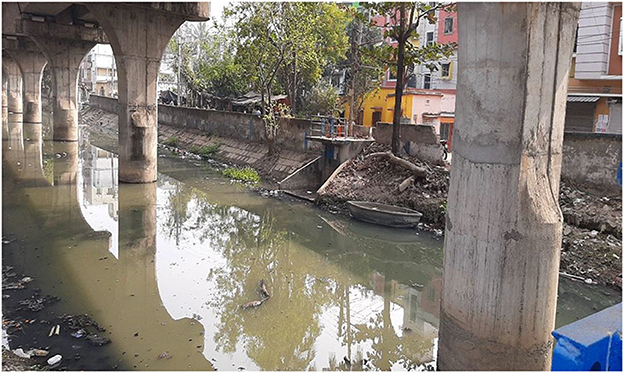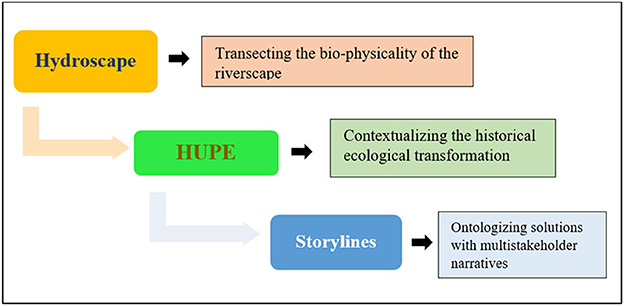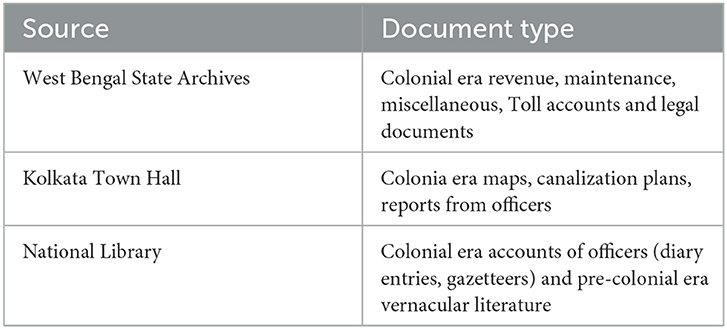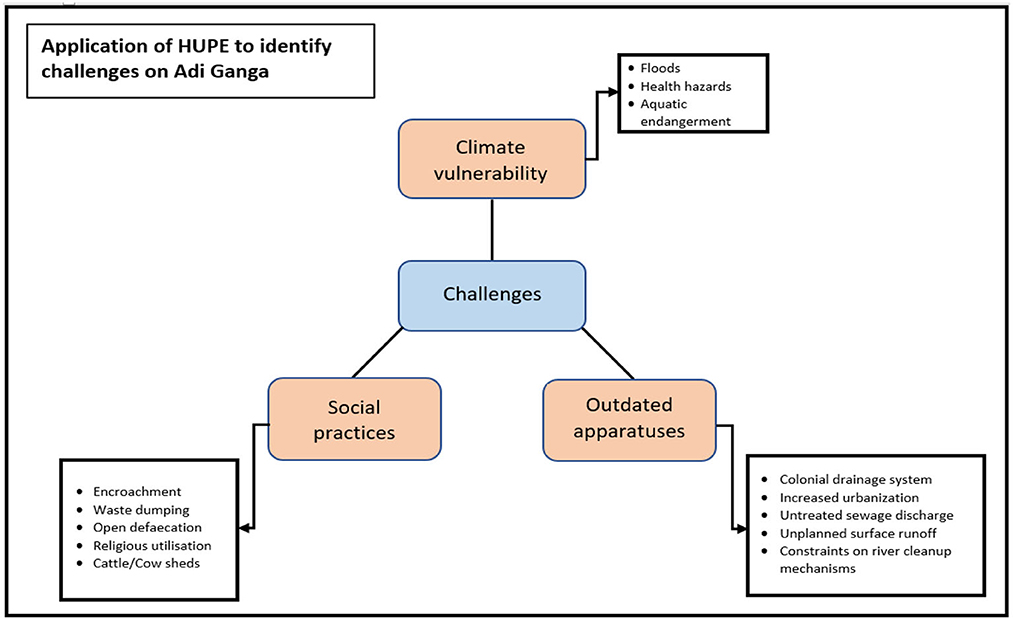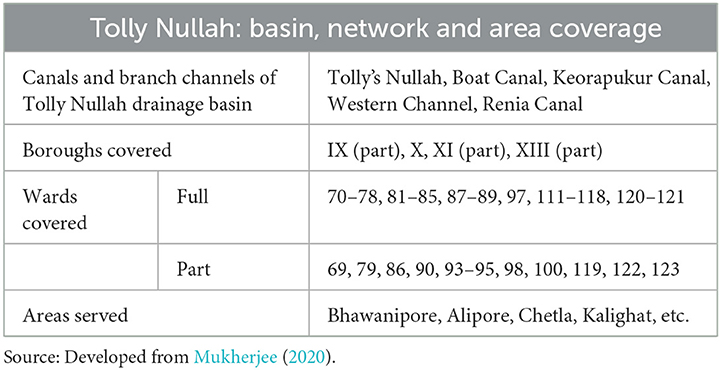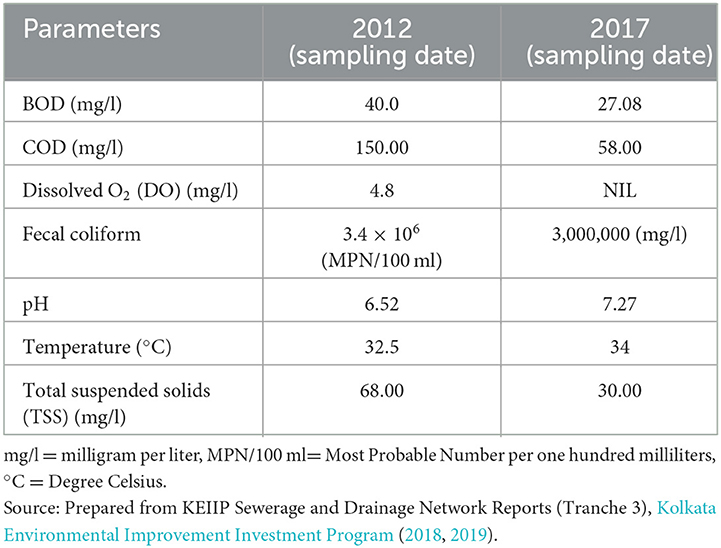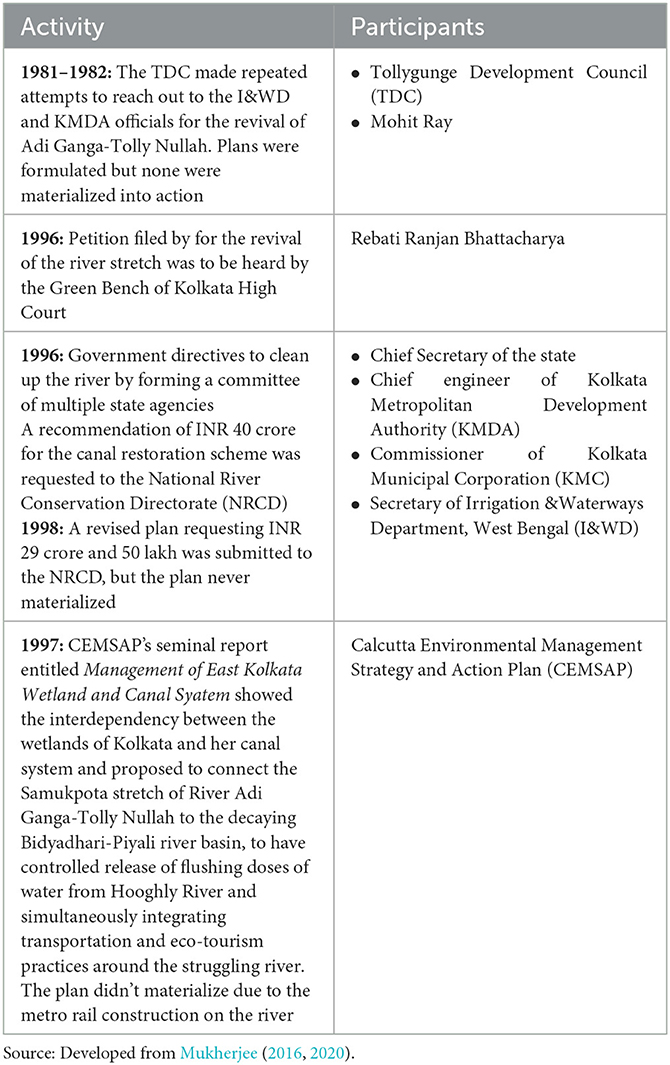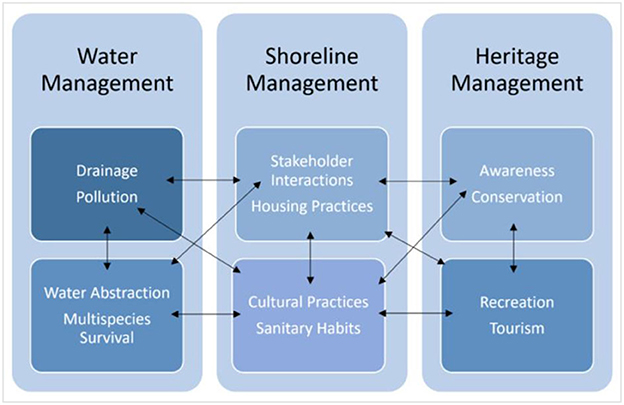- 1Rekhi Centre of Excellence for the Science of Happiness, Indian Institute of Technology Kharagpur, Kharagpur, India
- 2Department of Humanities and Social Sciences, Indian Institute of Technology Kharagpur, Kharagpur, India
Using the River Adi Ganga as the case study and implementing the historical urban political ecology (HUPE) framework, in this article we demonstrate multiple trends and trajectories that comprise city-river relationships. We explore coeval ontologies framing “river,” “riverine space” and “river rejuvenation” schemes, encapsulating “storylines” through the deployment of multi-modal (qualitative) research methodologies to trace and document plural perceptions on the river that was declared to be “dead”—the pillaged stretch that embodied the construction of the metro pillars. Media journalists and activists' narrative, that this act had slaughtered the river and robbed her of her original flows and services, has crafted a deep imprint on the citizens of Kolkata who consider the river as a stinking sink, offering minimal sewerage facilities to the city. Our paper challenges this linear depiction and weaves together positive moments, events and actions that keep the river flowing—shaping and in turn being shaped by (more-than)human actors across long temporal units and scales. We integrate the numerous agential and stakeholder voices attached to the river, shedding light on various (un)successful attempts to revive the river beyond global conceptualizations of what a “river” should be. We believe that the unfolding of this “pluriverse” will forge sustainable understandings of the river's current challenges and existing opportunities toward a collaborative blueprint through knowledge coproduction, stakeholder mobilization and actions. While our empirical frame of reference focuses on micro-realities surrounding a particular river on a specific urban hydroscape, our theoretical conceptualization framings and methodological applications will have potentials to be implemented at scales.
1. Introduction
Academic discourses on water have witnessed both conflicting and collaborative exchanges in recent decades, with the evolution of water's definition from its chemical analysis to its varied ecological, social and economic aspects. This finds special importance in the context of South Asia, whose topography riddled with tumultuous waterscapes and tampered by British colonists, exposed the imperial mindset of perceiving rivers as transactional objects. For them, rivers were nothing but a line on the map, identified through its hydrology that could be analyzed, tamed and manipulated for revenue generation 17 (Lahiri-Dutt, 2015). This posited the direct conflict existing on a river's identity as perceived between the river prepotent and river participants, with the former recognizing the waterscapes through its transactional benefits and the latter appreciating the river's societal contributions, gathered through human-water interactions over centuries (Swyngedouw, 1999; Karpouzoglou and Vij, 2017). A brief glance at our ancient history would reflect upon the importance of rivers in nurturing civilizations, with the flowing waters leading to development of agriculture, commerce and urbanization at different places and paces of time. The development of modern cities however, witnessed the various purposes served by water in an urban space, with its flows being engineered to dispose of urban waste, while simultaneously providing shelter to marginalized communities on its banks. Despite the dynamicity of a river's physical form, with her untethered movements challenging anthropocentric boundaries, the rigidity surrounding the concept of “space” around a river's shoreline, that often shelters vulnerable communities, exposes the fragility of urban diasporas in metropolitan centers. Rivers in South Asian urban spaces, despite their different geomorphological, social and political challenges, now continue to share certain similarities seated in developmental or urbanization practices, through butchering of waterbodies and overwhelming of shorelines with skyscrapers.
This emerging trend of flaunting “progress,” often under the guise of river restoration, rejuvenation and corrections, comes across as a front for anthropological manipulation of urban water, catering to state legitimization of corporate practices on ecological bodies. In many cases of urban waterbodies, especially rivers in India, prominent streams have been converted into either sewage arteries for the increasing urban demographic, or tamed for infrastructural transformations such as dams, bridges, real estate, thus continuing the colonial legacy of ecological abstraction in South Asian. The impact of these practices, increases by manifold when ideas such as river rejuvenation or restoration are disengaged from the hydrosocial aspects of water and are based on socio-political hierarchical decision making. The case of River Adi Ganga in Kolkata (see Figure 1), showcases the contemporary challenges of an urban waterscapes in the global South, impacted by socio-political and infrastructural practices that are deeply rooted in “colonial hydrology” (D'Souza, 2006), a case that is reflective of the situation of most South Asian rivers, and yet unique with the region's place-based narratives.
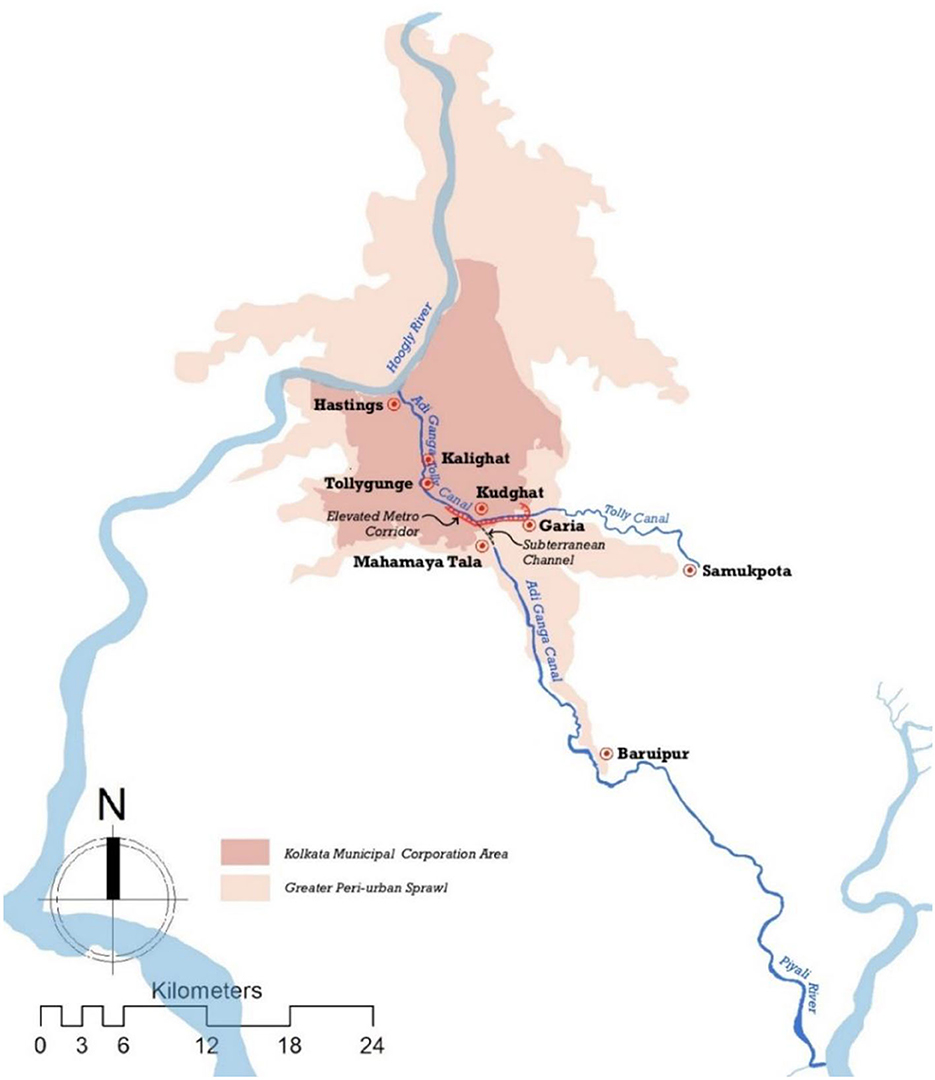
Figure 1. River Adi Ganga, Kolkata 2021 Source: Developed by Debika Banerji and Shreyashi Bhattacharya (Mukherjee et al., 2022).
We believe that the colonial period was watershed in terms of evolution of networked infrastructures of Kolkata–the Adi Ganga–Tolly's Canal being the first major hydraulic engineering intervention in this regard, yet, the river encountered many cycles of physical-political transformations, serving as an input and output to the shifting needs and aspirations of the city. We have analyzed the role of the river in trade-transportation-drainage-sewerage-sanitation, its material impacts on the urban waterscape, and how solutions to tackle the deterioration of riverine stretches should be designed from comprehensive-inclusive perspectives along a scoping exercise on the historical-social biography of the river. Thus, this historical narrative, we think is important in terms of placing the significance of temporality in understanding rivers, river-city interactions, and planning historically and culturally contingent solutions.
We use place based narratives to explore the water complexities of the urban river Adi Ganga in Kolkata. The challenges of Adi Ganga, a river enmeshed with centuries of heritage, has been analyzed with the Historical Urban Political Ecology (HUPE) framework to understand the multiple narratives of city-nature codependency and explore the many “storylines” existing on/upon the river's varied spatial stretch. These storylines probe into a deeper understanding of “modern water,” dissecting the diverse connotations of urban water abstraction, which is jotted with history, socio-cultural transformations and political aspirations that have shaped the river and vice versa (Linton, 2010). By exploring these many meanings of this river and the multiple narratives and practices surrounding restorative efforts, we unpack and validate “pluriversal possibilities” (Escobar, 2011) as a theoretical-empirical traction toward solution-oriented interventions for South Asian urban waterscapes. The river encountered many cycles of physical-political transformations, serving as an input and output to the shifting needs and aspirations of the city. We have analyzed the role of the river in trade-transportation-drainage-sewerage-sanitation, its material impacts on the urban waterscape, and how solutions to tackle the deterioration of riverine stretches should be designed from comprehensive-inclusive perspectives along a scoping exercise on the historical-social biography of the river. Thus, this historical narrative, we think is important in terms of placing the significance of temporality in understanding rivers, river-city interactions, and planning historically and culturally contingent solutions.
1.1. Scholarships on south Asian water: A brief review
The importance of water in the global south's societal ethos has long been discussed, whether through a deterministic approach of hydraulic society (Wittfogel, 1957) or witnessed in the flexible and evolving human-non human interactions, as exclaimed aptly by Lahiri-Dutt (2000, p. 2396), that “the river is neither outside society, nor is it just a thing out there in nature.” The case of Adi Ganga, whose cultural significance keeps evolving from a site of religious patronage to a transactional route, to a habitat for refugees that keeps absorbing and disseminating changes, stands true to this testament. This messy reality of water, shaped by various social relations was explored early by political ecologists (Swyngedouw, 1999, 2005, 2009; Bakker, 2003, 2004, 2013; Baviskar, 2007, 2009), focusing on the power equations surrounding urban water dynamics and its immersion into the scalability of urban water governance (Swyngedouw, 2005, 2009; Gandy, 2008; McFarlane, 2008; Bakker, 2011; Rattu and Véron, 2015).
Linton and Budds (2014) explained this further with the “hydrosocial” paradigm that had emerged out of political ecology of water, on “how water and society make and remake each other, over space and time,” harnessing on the hybridity between water and humans which is signified by the omission of the hyphen in “hydrosocial,” just as in a socionatural system where the two elements “socio” and “natural” cannot be separated or even distinguished (Wesselink et al., 2017). These pluralities of South Asian urbanity has played a major role in developing the eco-political and socio-environmental practices on and around Adi Ganga, with citizens historically and politically claiming and “inventing” spaces around the river (Miraftab, 2004). This also contributes to the discourse on materiality's surrounding the river, where the marginalized have been “othered” as contributors of unsanitary, polluting practices and criminality (Véron, 2006; Ghertner, 2011, 2012; Truelove and Mawdsley, 2011; Zimmer, 2012, 2015; Follmann, 2015).
The socio-political backdrop of river Adi Ganga, with the banks offering shelter to millions of refugees post partition (1947), Bangladesh Liberation War in 1971 and a space from migration of the city's informal workforce against the colonial space of hydrological interventions and bourgeoisie environmentalism (Baviskar, 2003), is a testament to the water's unruly dynamics, of “what is legal and what is legitimate” in urban waterscapes (Acharya, 2015). This core discourses, exploring the socio-political hegemonies surrounding “flows, allocation, infrastructure, institutions and framings” or “instances” of water (Budds, 2013, p. 303) can be redefined further by understanding the otherness of urban waterscapes that involves cultural connotations, consumption dynamics and place-based understandings through transgressions of disciplinary boundaries (Bryant, 1999).
The media and activists' portrayal of the decline and death of the river also fits within the larger urban (political) ecological scholarship on hydrological engineering and urban ordering of the statecraft and its simultaneous impact upon local ecologies and social displacements (Gandy, 2004; Baviskar, 2011; Castonguay and Evenden, 2012; Coelho and Raman, 2013; Singh et al., 2018; Coelho, 2020; Chitra, 2021). Mukherjee's exploration of the Historical Urban Political Ecology (HUPE) framework offers a historical perspective to the manipulated and evolving colonial ecosystem infrastructures surrounding the city and the river, exposing the micro-realities of eco-social multistakeholder collaborations in maintaining future sustainability of deltaic riskscapes such as Kolkata, where Adi Ganga's drainage network serves a prominent role in maintaining the flood relief balance for the city's municipal area. We have advanced Mukherjee's (2020) HUPE to trace urban riverine dynamicity's across historical human interventions, simultaneously with more-than-human interactions. Ranging from the “tidalectics” (DeLoughrey, 2007) governing the water's flow pattern to the multispecies interactions on the riverscape, HUPE offered a detailed understanding of the evolving drivers of climate change and vulnerability in the delta and also shedding light on socio-ecological resilience of Kolkata based on an integrated (more-than) “humans in nature” (Berkes and Folke, 1998) approach of the city's urbanization process, such as population growth and density, coping abilities of the ecological system with focus on social disadvantages surrounding marginalized groups sharing its resources (Dang et al., 2011; Noble et al., 2014).
2. Why Adi Ganga? Rationalizing the case study
River Adi Ganga originates at Hastings as a distributary of River Hooghly and flows southwards across the city of Kolkata to meet the Piyali river, which falls into the Bay of Bengal. Like River Hooghly, which is an eastern distributary of River Ganges, Adi Ganga is also revered in Hinduism due to her connection to River Ganga/Ganges. As per Hindu mythology, an ancient King Bhagirath had prayed to Goddess Ganga to purify the souls of his ancestors, who were cursed by Sage Kapil due to a misunderstanding. Goddess Ganga was considered the epitome of purity in Hinduism and thus it was suggested that only her touch could provide them salvation. It was Sagar's great grandson Bhagirath, who prayed to the Goddess and convinced her to descend upon the mortal realm in the form of a river. Interestingly, the goddess in her worldly form lost her way and couldn't find the location of the ashes. However, to fulfill her promise to Bhagirath, she branched herself into multiple channels or distributaries, that met the sea, thus forming the Ganga delta. As one of various branches met the ashes hidden in a cave, the souls of Bhagirath's ancestors were freed of the curse, which today is popularly known as the Legend of Sagar (Mukherjee, 2020). Even today, the Ganges and her various distributaries are considered as “Ma Ganga” or “Mother Ganga,” signifying the enmeshed natural-cultural agency of the river that has nurtured the city's evolution over centuries.
During the colonial period, besides being a major trade route between Calcutta and the Sundarbans, River Adi Ganga was molded into a servicing the drainage of the region as well, with her natural tidal regime offering cost effective solutions in consolidating the colonial regime. The subsequent degradation of the channel, after colonizers prioritized the railways over water transportation, affected the river sustainability, with increasing urbanization around her banks and lessening investments on her maintenance. This led to the complete transformation of the once heritage river into a foul, murky and defunct channel, presently reduced to a nullah, a sewage conduit (see Figure 2).
While the construction of the metro railway on a section of her stretch significantly affected her flow and ecology, the channel still plays an important role in maintaining the flood line balance of the southern municipalities of Kolkata. With majority of the river choked under untreated sewage, sediments and inorganic pollution, the region faces tremendous ecological hazards in the form of floods during monsoons. As most of the riverbank settlers are from marginalized communities, they face severe material and physical losses during these floods. Being a deltaic city, the role of waterscapes in the survival of Kolkata is paramount and the protection of an urban ecological heritage river such as Adi Ganga that transects across one of the densest localities of the city, is necessary in this regard.
The case of Adi Ganga, thus presents an interesting amalgamation of history and cultural ecology shaped by constantly evolving human-nature interactions rooted in a region's socio-geo-political context. Probing into these narratives and using the historical/archival approach to explore socionatural entanglements in the past, offer city-nature practitioners a temporal analysis of a cultural-ecological resource and its intangible heritage. The stories surrounding River Adi Ganga ranging from mythological accounts to contemporary oral narratives of childhood nostalgia, can steer the discourse on exploitation of urban waters toward water sustainability and inculcating transdisciplinary understandings of a riverscape into sculpting implementable solutions.
3. Methodology
3.1. Research design
Research and discussion on Adi Ganga aren't new in the Bengal's ecological context, with the river's pivotal role in the city's flood balance and the continual tampering with her flows since the construction of the metro railway on a section of her stretch. However, the lack of convergence of multidisciplinary discussions on the river's socio-ecological sustainability continued to create the schism among her stakeholders, academicians and the policymakers. The agenda of our team, comprising of people from different disciplinary backgrounds and interests, such as history, political ecology, geomorphology and cultural studies was to bring in our own understandings from understanding the messy hydroscape (Lord, 2014; Baetan and Lave, 2020) and her socio-political entanglements to analyzing the symbolism and cultural heritage associated in the river's volatile ecological existence by incorporating the HUPE and Storylines approach to relearn the varied perceptions surrounding the river's rejuvenation. The “storylines” approach implies the conveyance of “dominant, counter, and even suppressed” narratives for specific socio-ecological spaces that demand granular probing and analyses (Moore, 2007, p. 23). We explored the various narratives on Adi Ganga, through her history and from her different stretches and her varied sets of participants to analyze the different challenges for the river on her socio-spatial scales that through the involvement of her multiple stakeholder interactions and exchanges can converge to successful participatory governance (see Figure 3).
3.2. Methods
As we integrated the HUPE and Storyline approaches to study the Adi Ganga's case we have explored three qualitative methods to extrapolate our data, i.e., (1) Archival Research (2) Transect Walk, (3) Ethnography, and (4) Participant Observation. The archival research consisted of detailed accounting of primary accounts and secondary literatures, while our field explorations can be categorized into Transect Walks and Ethnographical methods to analyze the river from a geomorphological and socio-political perspective. We have combined and applied these methods to convey “storylines” on the Adi Ganga. While archives provided us with the edge to incorporate shifting temporalities on the life-cycle of the river, ethnography enabled us to map contemporary realties including more-than human interaction dotting this urban waterscape. The transect walk enabled us to understand the physicality-materiality of Adi Ganga across her many stretches enmeshed with budding tangible and intangible storylines.
3.2.1. Archival research
We have consulted various archives (Table 1)—colonial and vernacular, to connect and comprehend multiple snippets on the river, transforming across dynamic trajectories. The use of primary documents from West Bengal State Archives, Kolkata Town Hall Archives, National Library and secondary literatures have allowed us to revisit the route, travels and interactions on Adi Ganga across various temporal scales. Primary accounts from the archives include revenue and miscellaneous reports on the canal's excavation and maintenance, correspondences, diary entries and notes detailing the canal's legal ownership and statements from company officials. The primary accounts also provided us with plans and maps for further canalization projects proposed on the canal. Colonial accounts on the journey of Adi Ganga had also been documented by James Rennell, Hunter and O'Malley (Mukherjee, 2020) where the channel was portrayed to be draining into the Bidyadhari River below Baruipur, along with reports on Adi Ganga-Tolly Nullah's revenue generation, maintenance of the river and further plans for her canalization. Even before the British colonization, Adi Ganga found mention in the sixteenth and seventeenth century cartographic projections by Portuguese cartographers like Jao de Barros and Van Den Brouke as an important trade route in south Bengal.
Medieval era vernacular literature such as the Manasamangal by BipradasPipilai, the Chandimangal by KabikankanMukundaram Chakrabarti, the Raymangal by Krishnaram Das and other works like the Satyanarayan Katha by Ayodhya Ram, Shitalamangal by Harideb and Kalu Rayer Geet by Dwija Nityananda as well as Vaishnavite Saint Shri Chaitanya's journey on the river Adi Ganga in the Chaitanya Bhagabat have mentions of Adi Ganga as an important route of trade and travel in Bengal's socio-economical history (Bandyopadhyay, 1996; Mukherjee, 2016, 2020).
3.2.2. Transect walk1
We have conducted transect walks along the entire river stretch from her junction at Hastings to her canalized stretch at Samookpota that was designed to fall into River Bidyadhari as well as her original route up to Surjyapur where it currently diverges into different branches to meet the Piyali river. The transect walk has allowed us to observe the flows and shoreline interactions of the river across her original stretch that was canalized and turned into a sewer, the stretch that has been pillarized by the metro railway and the section of the river that turned into a paleochannel and finally emerged as a cleaner section at the fringes of Kolkata. The walk allowed us to observe the spatial planning surrounding the river that was transformed into a drainage network for Kolkata's southern municipality, to explore the religious-cultural connotations surrounding the river near pilgrimage sites such as Kalighat or the Rashbaris, and the lives of marginalized communities ranging from migrant squatters to prostitutes finding shelter in her banks and noticed local government initiatives on the river clean-up against lack of ecological awareness among the local community.
3.2.3. Ethnography
We interviewed and held formal-informal discussions with residents from the different stretches, varying from different socio-economical strata. We have interviewed houseowners (old and new) and their perspectives on the river's transformation, the perspective of the squatter communities across different stretches who have been evicted and since resettled on the banks and their reactions to living alongside a filthy river. The prostitutes living across different stretches of the river allowed us to observe their micro-realities of existing alongside a holy river which people and state continue to contaminate. Interviews were held with state apparatuses managing the river stretch at different level, ranging from officers at Irrigation and Waterways Department, Pollution control Board and municipal governance officials from Kolkata Municipal Corporation and local youth engaged in the river cleanup. We held onsite Focus Group Discussions with elderly men and women, shopkeepers, priests and local club members living on the banks on their attachment to the river, oral histories, current challenges and their hopes for Adi Ganga.
3.2.4. Participant observation
We observed the flows and obstructions of the river at different spatial stretches along with the water's different interactions with the participants. From Adi Ganga's free flowing emergence at Hasting's to her sacrality induced abstraction at the pilgrimage sites, and the local governance practices in cleaning up the channel, the multiple synergies existing on the river's spatial stretch was observed and analyzed by our team of researchers. We also witnessed the various riverfront inequalities and evolving stakeholder understanding of the river's social-ecological problems that impacts Adi Ganga's current existence.
4. One river, numerous challenges, multiple timeframes: An empirical discovery
The story of Adi Ganga's journey, from a river of religious-social importance to a transactional route and finally a sewer struggling to survive, contextualizes the need to understand modern South Asian urban rivers through a lens of historical-political analysis, where colonial legacies continue to play a significant role in an ecological resources' contemporary struggle. The application of the HUPE framework in the study of Adi Ganga, offers a detailed understanding of the river's transformative challenges and helps in identifying her needs in the context of increasing anthropocentric threats. The threats posed from climate vulnerability such as floods and concurrent diseases affect both human-non human participants, that are significantly enhanced with present social and state practices. The continuation of the colonial hydrological system against the changing geomorphological and urban needs are combatted with the social practices stemmed in ecological non-awareness.
The HUPE analysis of Adi Ganga points toward (1) Climate Vulnerability (2) Social Practices and (3) Outdated Apparatuses, as broader but major challenges of the river, which can further be categorized into various sub-challenges that shed light on micro-realities on the waterscape, shaped by local socio-ecological and political turnabouts (see Figure 4). However, the interconnected nature of the socio-ecological challenges as well as the political nature of Adi Ganga's degenerative state, require a deeper inspection of these complex riverine issues, in order to highlight the scope for implementable and sustainable solutions in future. These challenges and sub-challenges have thus, been further sectioned into three prominent issues, i.e., (a) Drainage Network, (b) Intra-Institutional Impediments, and the (c) Metro Railway, in order to probe in the diverse yet situated narratives on and around Adi Ganga.
4.1. Historical drainage networks
The river Adi Ganga played an important part in the intricate colonial drainage network system of the city that was developed three centuries ago keeping in mind the geography and fluvial dynamics of the deltaic terrain of erstwhile Calcutta. The naturally “bowl shaped” feature of the city, with the central locations of Kolkata at a lower elevation, made it prominent to pump out the sewage from these locations to different outfall channels, under the colonial “Town system.” This system was developed by crafting around the tidal nature of the city's rivers and her various channels, such as River Hooghly and her distributary known as Adi Ganga, that was manipulated into carrying out the sewage of the southern stretch of Calcutta (Mukherjee, 2020). This old bed of the Ganges was re-excavated by William Tolly from Hastings to Samukpota in 1775–1777, leading to her new identity as Tolly's Nullah or Tolly's Canal. The Nullah was not provided with any sluices or lock gates due to her tidal nature, leading to deposition of silt over the years. The colonial government would facilitate the channel's regular clean-up and maintenance through dredging, clearing up of silts on the banks, prohibiting dumping of human waste, animal carcasses etc., but over the years, the shifting priorities to the railways and defuncting hydrological apparatuses, urban development agendas along shorelines and political turmoil leading to increase in squatters on the banks, Adi Ganga-Tolly Nullah over the years, turned into a waste dumping ground for the state and the locals, like most South Asian urban rivers. The river Adi Ganga at present, is part of the Tolly Nullah basin that takes care of the drainage of several heavily residential districts of southern Kolkata and that falls under the supervision of Kolkata Municipal Corporation (see Table 2), where over the last century, the river had been dealing with the region's dry and storm weather flow (see Figure 5).
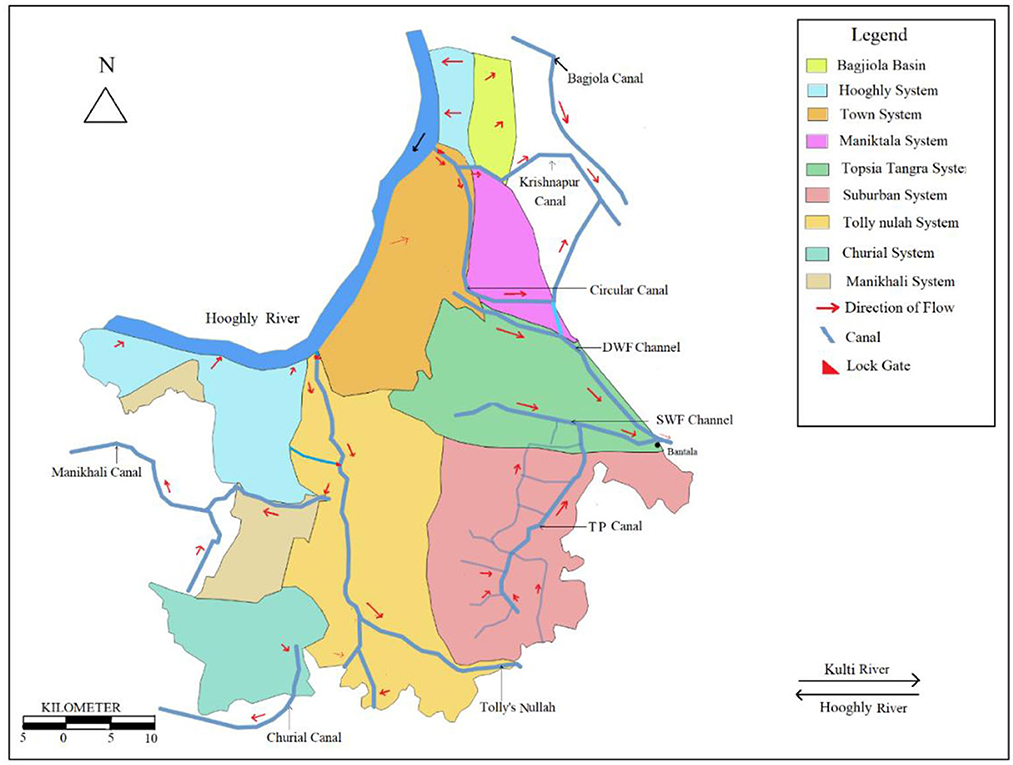
Figure 5. Major drainage systems of Kolkata. Source: Mukherjee (2020).
The accumulation of untreated sewage and plastics on her heavily silted banks, makes the place risky, especially during the monsoons, when the heavily silted river banks fail to balance the flood line causing flash floods across southern Kolkata and induce recurring material as well as physical damages for the communities living on the banks (see Figure 6). Beside the natural and man-made challenges faced by the canal, the problems lying in the historic interventions of the drainage system that were deemed as revolutionary once, now present subsequent hurdles in the hydrological management of the basins. The drainage system that was designed to tackle immediate urbanization on the banks now face challenges with unchecked urban sprawls, encroachment, lack of ecological awareness, pollution, inadequate maintenance and “developmentalist interventions” over the past decades. The unplanned diversion of surface runoff from one subbasin to another cause overloading on the existing drains, leading to flash floods (Mukherjee, 2020). A study conducted in 2015 by the Kolkata Municipal Corporation (KMC) and British Deputy High Commission showed flooding in various parts of the city in rainfall of 300–400 mm in 25 h under 3 and 5 m storm surge during high tides [Kolkata Municipal Corporation (KMC) British Deputy High Commission, 2017; Mukherjee and Bardhan, 2021].
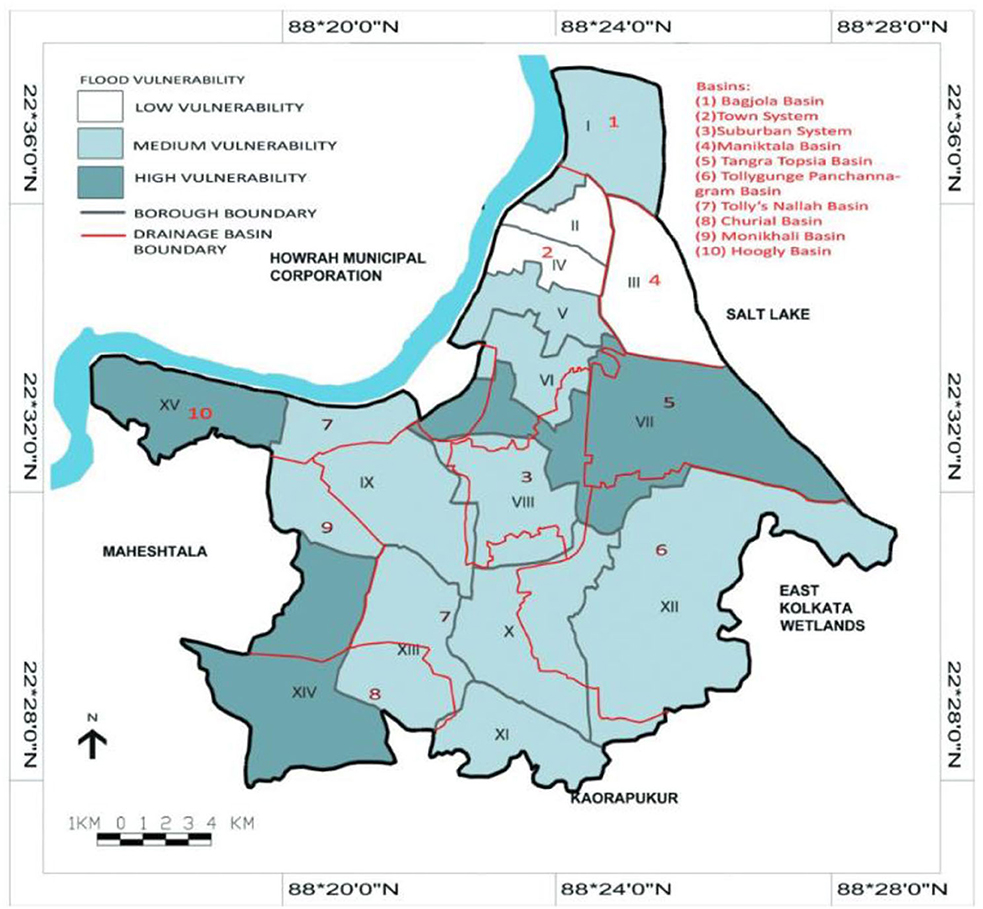
Figure 6. Borough wise flood vulnerability map of KMC. Source: Mukherjee and Bardhan (2021).
The increased haphazard dumping of garbage on riverfront by locals, ranging from flowers, household discards, plastic packets and in certain cases carcasses from the nearby slaughterhouses (revealing the lack of ecological awareness among local communities), has also put extreme pressure on the age-old drainage system that is already struggling with malfunctioning locks and pumps, or systems with reduced pumping capacity. The lack of maintenance of the canal outlets, outfall structures which are in dire need of repair and absence of any working sewage treatment plants (STPs) existing on the river has raised the canal bed due to silt accumulation, leading to 15%-50% reduction in carrying capacity of Tolly's Nullah and the entire canal system of the city (Mukherjee and Bardhan, 2021).
4.2. Intra-institutional impediments
At present, the river has been demarcated separately as Adi Ganga (Garia-Samukpota and Garia-Surjyapur stretch) and Tolly Nullah (Hastings-Garia stretch) with the Irrigation and Waterways Department of West Bengal (IW&D) managing “Adi Ganga” and Kolkata Municipal Corporation (KMC) and Kolkata Metropolitan Development Authority (KMDA) managing “Tolly Nullah.” As the river stretch managed by the KMC falls under heavily residential zones, the agency faces various difficulties in managing their respective stretches, ranging from infrastructural limitations to socio-cultural obstacles, as discussed in the following:
4.2.1. Ecological unawareness
The dilemma surrounding Adi Ganga's revival or rejuvenation depends on the dual identity of the river crafted by cultural and statist developments. Kalighat, one of the most densely populated localities of Kolkata had been built around the Kali temple, an important pilgrimage shrine of Hinduism, which rests on the bank of Adi Ganga. The sacrality surrounding the region has turned the river channel in to a common space for throwing away of flowers, incense sticks, ritual offerings along with the increasing load of sewage in this densely urbanized space. Similarly in the locality of Kudghat, the construction of metro pillars has affected not only the natural flow of the channel but also concretized the channel's identity as a nullah in the minds of locals, where residents throw daily garbage into the river, justifying their actions by suggesting that the channel is already a sewer. Awareness campaigns have been organized by the KMC, where the agency has put up banners on the river banks prohibiting the drinking, storing or utilization of the river water, dumping of household garbage as well as religious offerings and bathing or defecating on the river banks. Heritage walks alongside the river stretch have also been organized by the agency to elicit some awareness among the residents on the river's heritage, but to no avail.
4.2.2. Pollution
The unchecked urbanization around the river stretch along with construction of the metro railway at present has put immense pressure on the colonial era canal system, turning this important channel into a toxic waste filler. KEIIP report on the chemical analysis of Tolly's Nullah water quality has showed high to moderate levels of biochemical oxygen demand (BOD), chemical oxygen demand (COD) and coliform in the water over the past years (Table 3).
The tidal regime of the river also affects the quality of water in the channel, as shown in the differing sets of sample data recently collected from different stretches of the river (Table 4). The BOD, COD and coliform bacteria count in the river water significantly increases during low tide, while the oxygen level is found to be negligent at almost every stretch which suggests that no life can exist on the river. Tolly Nullah-Adi Ganga at Kalighat proves to be the most unsanitary stretch with the highest total coliform count during the entire tidal regime.
4.2.3. Technological restraints
Many of the KMC workers employed contractually for river clean up navigate the channel on small boats and pick up flowers, plastics and other inorganic waste from the river, at regular intervals. While garbage arresters are placed at certain spots in the channel to catch bulk amounts of floating waste, the workers are provided some gloves and makeshift equipment made from bamboos to pick up plastics manually from the river. Recent interim measures taken up by the KMC to check polluting of the river stretch are [WD and MA memo no. 89-JS (NG), Department of Urban Development Municipal Affairs Government of West Bengal, 2021]:
• Urgent dredging at the most polluted stretch of the upstream of Tollys Nullah-Adi Ganga upto 4.6 km.
• Demolition of makeshift toilets on the river banks and construction of 77 community sanitary latrines.
• Demolition/Eviction of khatals (cow and cattle sheds) on the river bank.
• Temporarily fencing vulnerable spaces at Borough X and XI for 2 kms, restricting access to the river bank and minimizing manual dumping of garbage in the river.
• Installing 10 floating garbage arresters, 4 organic composters and carried out awareness campaigns.
Despite the above measures, officers supervising the channel's clean-up have expressed their dismay at working on the river with limited tools, as untreated waste water continue to spill in to the river. The tidal regime of the river also restricts the use of bioremediation practices, thus highlighting the need for sewage treatment plants on the river bank to check the river's pollution and her subsequent revival.
4.3. “Metro”-politan river: Post-colonial challenges
After the independence of India, with changing political situations across the state and especially in Kolkata which was still reeling from influx of refugees after the Indian partition in 1947 and the Bangladesh Liberation War in 1971, the river front became a place of shelter for the marginalized communities trying to find livelihood opportunities in a megapolis. Simultaneously, the river's condition began to worsen with the increasing flow of untreated waste from drainage systems, transforming her into a local toxic and hazardous dumping ground, leading to various calls for Adi Ganga's clean up in the last decades of the twentieth century by different agencies (see Table 5).
In 1999, the plan for construction of the metro railway on the riverbed between Tollygunge to Garia was floated by the then state government, causing a stir among prominent environmental activists who deemed the project as unscientific and illegal. However, a petition filed by activist Subhash Dutta against the metro extension scheme in the Kolkata High Court failed to stop the project when the court gave verdict in favor of the State under the Section 11 of the Railways Act 1989.2
In 2001, the construction work began on the river bed by embedding 300 pillars on the riverbed of the already choked waterbody, which led to the brutal eviction of more than 40 thousand squatters and slum dwellers who had been living on the river stretch for decades, while grassroot organizations such as the Ucched Bachao Jukta Mancha (UBJM), Manthan, Association for Protection of Democratic Rights, Nari Nirjatan Pratirodhn Mancha, Sanlap, All India Progressive Women's Association, and Maitree mobilized protests and demanded the squatters rehabilitation (Mukherjee et al., 2023). The eviction started on September 22, 2001 and continued in phases, with Rapid Task Forces being used to violently suppress the protests as bulldozers demolished makeshift houses of these vulnerable communities. Community kitchens that were organized for the evicted squatters, stood up as a symbol of hope for reclaiming of their riverine stretches and thus were soon followed by the state police shutting them down (Mukherjee, 2020).
4.3.1. The dying river
The aftermath of the metro rail project on the river, witnessed gradually despondent and lessening mobilizations surrounding the revival of Adi Ganga, which was declared “dead” by many of the activists. The metro stretch has hindered the natural flow of the channel and with the added debris, sewage and siltation, the centuries old drainage network that was designed to hold 100 mm of water per day, now gets flooded easily, when torrential rain and tropical cyclones exceed the water limit to upto 200 mm per day (Chatterjee, 2020). Besides, over time many of the squatter families have relocated to other parts of the same river stretch, which has become more ecologically at risk over time. At present, 49,000 people now live in the slums on the banks of Tolly's Nullah, which is almost 20% of the population of the region (Mukherjee and Bardhan, 2021), putting them in a vulnerable state of existence.
This casual acceptance of the Adi Ganga-Tolly Nullah as a waste disposal ground among the state and local community, transcending the cultural ethos surrounding her heritage and ecological importance blatantly exposes the continuation of colonial water legacy, that consists of not only the hydrological system but also the policy of segregation and exclusion of the non-state stakeholders whose agential undertakings are still not taken into consideration while exploring river conservation. Declaring river policies without exploring these differing and changing hydrosocial understandings, cutting across the intra state rankings have resulted in Adi Ganga's current struggling existence and will continue to do so if shared accountability and collaborative practices are not given immediate platforms for Adi Ganga's survival in future.
4.3.2. Blurring bourgeoisie environmentalist notions
While colonial hydrological may have significantly altered the future of South Asian rivers by dissecting water's social and economic values, the continuing practices of water hierarchy in post-colonial India played a major role in decline of most urban rivers, especially Adi Ganga. The development of the metro plan and its implementation against divided forms of activism was reflective of the various conflicts existing on Adi Ganga's shorelines regarding her “ownership.” Even in the pre-metro phase, the river restoration protests for Adi Ganga saw two different forms of activism surrounding the river, consisting of the environmentally aware middle class who were concerned in protecting the ecological heritage and personal nostalgia attached to the river and the other consisting of grassroot mobilizations where the focus was meant upon the lives and livelihood scenarios shared by the marginalized communities living on the river banks for decades and yet reduced to invisible actors with no agency on the river.
These diverging narratives of river protection affected Adi Ganga's future severely, with no common ground being explored among these multiple stakeholders on necessary steps required for the river's survival. The lack of seamless communication strategies on the river's importance, challenges and steps for conservation among these stakeholders allow the continuation of hydrosocial malpractices on Adi Ganga. Our interactions with different sets of respondents ranging from river participants, activists and policymakers reflect upon the challenges faced by each respondent, rooted in their historical-political understanding and experience of the river and the possible remedies as perceived by them (Table 6).
The shoreline participants, consisting of residents, business owners, club members and temple authorities, share their perceptions on Adi Ganga by engaging with an individualistic approach. Families who have lived here for many generations offer a nostalgic approach toward the river's revival, as they lament of their fading childhood memories around the river. The local club committees, consisting of local residents belonging to “reputed backgrounds” share same sentiments surrounding cultural practices on the river. Almost all of them blame the squatters for turning the river into a sewer channel, suggesting their unsanitary practices as a direct contributor to the river's detrimental state. The squatters, while vehemently denying this, state that they are the worst sufferers of the channel's poor state. Beside living with the foul smell and murky water, they are forced to live with this unsanitary water when it floods their homes during monsoons, posing serious health hazards to the residents.
The idea of Adi Ganga's sacrality and sanitation is however, presents an interesting conundrum among religious community surrounding the river. Despite announcements and warnings from authorities, pilgrims continue to take bath in the river, citing the water's religious significance among Hindu community. Few priests from the Kalighat temple blamed the government for turning the “holy river” into a sewage channel, but implored that it didn't affect Adi Ganga's sacredness. A quick discussion with the state agencies as well as activists reveals that using the cultural prominence of the river to dissuade people from throwing garbage into the river have been proven unsuccessful over the years, with the lack of concrete sewage treatment measures and transparent river rejuvenation policies from the government.
5. Weaving “storylines” toward solutions through HUPE
The integration of HUPE analysis for the river Adi Ganga offers a broad overview of the identified challenges and its complexities from multistakeholder (both human and non-human) narratives, thus positing a platform to address them through seamless storylines. The HUPE storyline has reflected upon the divisions existing among Adi Ganga's management practices, namely ecological, socio-cultural and political. In order to revive the river under the current circumstances, or to posit her a chance of survival, these divisions need to be blurred. Our interactions on the river have recognized the need for specialized understanding of Adi Ganga's water, shoreline and heritage management, which require entangled-integrated practices for the river's rejuvenation (Figure 7). The challenges of pollution, abstraction and defunct apparatuses blur the land-water binaries and hierarchies, with the integration of ecology based social-cultural practices rooted in awareness generation, socially just housing and other infrastructural development, and introduction of innovative ideas for conservation of the river's heritage by entangling water practices with recreational livelihoods.
Elaborating upon the above illustration, one can notice the cross fertilization of opportunities that can be crafted into solutions. Combating the challenge of outdated drainage and increasing pollution on the river, it is imperative to restrict the untreated sewage falling into the river. As the tidal regime of Adi Ganga refuses bioremediation procedures, it is necessary to install STPs for the drainage or find a new a new drainage outfall for the region. Besides, the eviction of marginalized communities on a recurring basis against the blatant conversion of the riverscape into a real estate honeycomb for affluent classes that has been increasing the waste discharge presents the continuation of colonial era practices of discrimination and exploitation. This necessitates the need for transparent and community friendly river practices where unsanitary, exploitative practices water practices are combatted with infrastructural innovation and cultural integration.
The first step in this process would be recognizing and dissemination the importance of “waste” among the local community who often engage in illegal and unsanitary practices of waste promotion (Table 7). Regulation of infrastructural development on the riverscape, creating and implementing strict norms for dumping of plastic wastes, installing STPs across the river stretch and preparing a revised drainage basin for the region is necessary to facilitate trust and accountability among all the river stakeholders. The maintenance of the river stretch should also be treated as joint responsibility between state and all her actors by raising awareness surrounding the river's heritage and ecological importance to combat pollution from domestic discharge and religious tourism by introducing modules on waste segregation, river ecology, importance of city-river's interconnected drainage-climate change scenario among local schools, colleges, clubs and cultural associations on a long-term scale.
The highly intervened stretch requires extensive river care and maintenance from the state as well as the community through incorporations of scientific expertise and citizen science. While the KMC, KMDA, IW&D, and PCB float the various norms and regulations for river clean-up, local participants of the policies such as supervisors, contractors and youth employed by them have better understanding of local ethos and practices. Besides training these workers with innovative and modern technologies, it is also important to recognize their opinions on maintaining the river, which can contribute immensely in engaging more community participation. Creating a database for local-state interactions also offers citizens a better understanding of their stakeholdership and making them more engaged in the river's survival.
The need for multidisciplinary-collaborative platform to explore and understand the riverine ecology of urban Kolkata is evident, where various aspects of the city's socio-ecological scenario is studied, analyzed and interpreted through innovative dissemination strategies. The lucid understanding of these scenarios can offer the various stakeholders, opportunities to circulate the diverse complexities of the river to their respective agencies and offer a holistic space for curating discussion-based decisions. Awareness campaigns, educational curriculums, technical apparatuses and development of heritage based recreational tourism can offer implementable urban riverine policy suggestions that can contribute in successful application of participatory governance on Adi Ganga.
6. Conclusion
The deeply embedded socio-ecological complexities surrounding the riverscape of Adi Ganga has made it pertinent to develop “solutions” that comprehends its extensive array of interpretations, such as solutions for whom and solutions by whom? The empirics surrounding Adi Ganga's history and political ecology have evidenced the interplay of political-ecological-social transformations encompassing the river, where the city and nature's interdependency has been exploited by colonial masters and later state mechanisms, while ignoring the agencies of various “others” living on and by the river. Thus, the need for reifying Adi Ganga, cannot be summarized under the vague objective of neo liberal rejuvenation practices, where soft capitalism and bourgeoisie environmentalism overwhelms the ineradicable contributions of the vulnerable participants of the river. The task of resuscitating Adi Ganga, would require the knowledge of her legacy not only through her historicity but also in appreciating her ecological heritage, that has been shaped by various spatio-temporal interactions with her many participants. The intricate human-non human linkages existing and evolving on Adi Ganga, expresses the dynamicity of interactions across her multiple stakeholders, that is captured aptly by the “storylines” approach. The compilation and evaluation of the archival voices as well as silences, along with the present narratives and counter narratives from stakeholders, whose voices are often suppressed or unheard, bring forth a comprehensive understanding of Adi Ganga, as a part of Kolkata's “living system infrastructure” and posits a platform for transitioning from knowledge accumulation to action policy (Mukherjee, 2022).
It is crucial to combat the impact of the anthropocene on Adi Ganga, considering the continued degradation of flood efficacy of Kolkata's fluvial systems and the increasing climate change induced vulnerabilities in the delta. Investigating the root of this problem, would first necessitate the discarding of the colonial demarcation of South Asian rivers as “chaotic” and “unruly” and the continuance of colonial hydrological practices against indigenous knowledge. Rerouting the Adi Ganga's ecological legacy would remain only a buzzword unless her current demographic challenges are addressed with a deeper ontological understanding. Replacing the current Eurocentric model with popular and local scientific knowledge, and integration of the cross-sectoral understanding of the river's management can provide a glimpse of the pluriversal possibilities in rejuvenating Adi Ganga that voices the role of the “many worlds” existing beyond western hydro science in river discourses (Escobar, 2020). These practices reflect the various river epistemologies of the global south, where post-colonial waters can be unchoked of the political hubris and impediments, to move toward a socio-ecologically just and sustainable future. These can be attained by analyzing the river-society interactions from a multiscalar perspective and collaborating the technical expertise with the regional stakeholder “co-flows,” that can assist in developing long term river conservation-management strategies for South Asian urbanscapes.3
Data availability statement
The original contributions presented in the study are included in the article/supplementary material, further inquiries can be directed to the corresponding author.
Ethics statement
Ethical review and approval was not required for the study on human participants in accordance with the local legislation and institutional requirements. The participants (legal guardian/next of kin) provided written informed consent to participate in this study.
Author contributions
SB conceptualized and designed the research, conducted data collection and analysis, and led the writing. JM conducted overall research supervision, provided advice on research design, data analysis, and contributed to writing. AC contributed to conceptualization of research, development of data collection methods, and advised on writing certain sections. RG contributed in research design, data analysis, and reviewing the manuscript. All authors contributed substantively to the manuscript and approved the submitted version.
Acknowledgments
We extend our gratitude toward the people living and working on/beside Adi Ganga, the state and non-profit agencies, for dedicating their time and participating in the data collection process. We are also thankful toward the EU-ICSSR funded EqUIP Project—Towards a Fluid Governance: Hydrosocial Analysis of Flood Paradigms and Management Practices in Rhone and Ganges Basins (India, France, and Switzerland) in supporting the field research for this study.
Conflict of interest
The authors declare that the research was conducted in the absence of any commercial or financial relationships that could be construed as a potential conflict of interest.
Publisher's note
All claims expressed in this article are solely those of the authors and do not necessarily represent those of their affiliated organizations, or those of the publisher, the editors and the reviewers. Any product that may be evaluated in this article, or claim that may be made by its manufacturer, is not guaranteed or endorsed by the publisher.
Footnotes
1. ^Transect walk is an interdisciplinary information gathering method applied to show, study and describe a land/waterscape, its features, resources and varieties, by identifying and diagramming the given transect route.
2. ^Based on the archaic colonial Act of 1890, it gave railways imprimatur to construct in or upon, across, under or over river, canals, brooks, streams or other waters as it thinks proper.
3. ^The concept of urbanscapes has emerged and evolved across multiple disciplines, with focus on broader concepts such as urban design, architecture, landscape architecture and landscape urbanism that contribute toward the development of sustainable solutions. Recent works on the concept, now focus beyond the physical demarcations and include the social aspects that are shaped by multiple spatio-temporal variables (Sheih et al., 2017; Shamlou et al., 2018).
References
Acharya, A. (2015). “The cultural politics of waterscapes,” in The International Handbook of Political Ecology, ed. R. L. Bryant (Cheltenham: Edward Elgar Publishing Limited). doi: 10.4337/9780857936172.00036
Baetan, J., and Lave, R. (2020). Retracing rivers and drawing swamps: using a drawing tablet to reconstruct an historical hydroscape from army corps survey maps. Hist. Methods 53, 182–198. doi: 10.1080/01615440.2020.1748151
Bakker, K. (2003). Political ecologies of water privatization. Stud. Polit. Econ. 70, 35–58. doi: 10.1080/07078552.2003.11827129
Bakker, K. (2011). “Commons versus commodities: political ecologies of water privatization,” in Global Political Ecology, eds R. Peet, P. Robbins and M. J. Watts (London: Routledge), 347–370.
Bakker, K. (2013). Neoliberal versus post-neoliberal water: geographies of privatization and resistance. Ann. Assoc. Am. Geogr. 103, 253–260. doi: 10.1080/00045608.2013.756246
Bandyopadhyay, S. (1996). Location of the Adi Ganga palaeochannel, South 24 Parganas, West Bengal: a review. Geogr. Rev. India. 58, 93–109.
Baviskar, A. (2003). Between violence and desire: space, power, and identity in the making of metropolitan Delhi. Int. Soc. Sci. J. 55, 89–98. doi: 10.1111/1468-2451.5501009
Baviskar, A. (2007). “Introduction: waterscapes: the cultural politics of a natural resource,” in Waterscapes, ed. A. Baviskar (Delhi: Permanent Black), 1–11.
Baviskar, A. (2009). For a cultural politics of natural resources. Econ. Polit. Week. 38, 5051–5055.
Baviskar, A. (2011). What the eye does not see: the Yamuna in the imagination of Delhi. Econ. Polit. Week. 46, 45–53.
Berkes, F., and Folke, C. (1998). “Linking social and ecological systems for resilience and sustainability,” in Linking Social and Ecological Systems: Management Practices and Social Mechanisms for Building Resilience, eds F. Berkes, C. Folke and J. Colding (Cambridge: Cambridge University Press).
Bryant, R. L. (1999). A political ecology for developing countries? Progress and paradox in the evolution of a research field. J. Econ. Geogr. 43, 148–157. doi: 10.1515/zfw.1999.0010
Budds, J. (2013). Water, power and the production of neoliberalism in Chile, 1973–2005. Environ. Plan. D. 31, 301–318. doi: 10.1068/d9511
Castonguay, S., and Evenden, M. (2012). Urban Rivers: Remaking Rivers, Cities, and Space in Europe and North America. Pittsburgh: University of Pittsburgh Press. doi: 10.2307/j.ctv10tq43d
Chatterjee, A. (2020). The Cyclone Amphan and Its Impact in the City Kolkata. Available online at: https://medium.com/@anjan.chatterjee/the-cyclone-amphan-and-its-impact-in-the-city-kolkata-c63aadc51dfa (accessed July 18, 2022).
Chitra, V. (2021). Remembering the river: flood, memory and infrastructural ecologies of stormwater drainage in Mumbai. Urban Stud. 59, 1855–1871. doi: 10.1177/00420980211023381
Coelho, K. (2020). Lines in the mud: tank eco-restoration and boundary contestations in Chennai. Urbanisation 5, 121–139. doi: 10.1177/2455747120965508
Coelho, K., and Raman, N. (2013). “From the frying-pan to the floodplain: negotiating land, water and fire in Chennai's development,” in Ecologies of Urbanism in India: Metropolitan Civility and Sustainability, eds A. Rademacher and K. Sivaramakrishnan (Hong Kong: Hong Kong University Press), 145–168. doi: 10.5790/hongkong/9789888139767.003.0006
Dang, N. M., Babel, M. S., and Luong, H. T. (2011). Evaluation of food risk parameters in the Day River Flood Diversion Area, Red River Delta, Vietnam. Nat Hazards. 56, 169–194. doi: 10.1007/s11069-010-9558-x
DeLoughrey, E. (2007). Tidalectics: Navigating Repeating Islands in Introduction to Routes and Roots. Honolulu: University of Hawai'i Press.
Department of Urban Development and Municipal Affairs Government of West Bengal (2021). Submission of Quarterly Progress Report for the Period From March 2021 to May 2021 in Compliance With the Order of Hon'ble NGT Under OA-200/2018. Memo no 89-JS (NG). Department of Urban Development and Municipal Affairs Government of West Bengal.
D'Souza, R. (2006). Water in British India: the making of a colonial hydrology. Hist. Compass 4, 621–628. doi: 10.1111/j.1478-0542.2006.00336.x
Escobar, A. (2011). Sustainability: Design for the plriverse. Development. 54, 137–140. doi: 10.1057/dev.2011.28
Escobar, A. (2020). Pluriversal Politics: The Real and the Possible. Transl. by David Frye. Duke: Duke University Press. doi: 10.2307/j.ctv11315v0
Follmann, A. (2015). Urban mega-projects for a ‘world-class' riverfront—the interplay of informality, flexibility and exceptionality along the Yamuna in Delhi, India. Habitat Int. 45, 213–222. doi: 10.1016/j.habitatint.2014.02.007
Gandy, M. (2004). Rethinking urban metabolism: water, space and the modern city. City. 8, 363–379. doi: 10.1080/1360481042000313509
Gandy, M. (2008). Landscapes of disaster: water, modernity, and urban fragmentation in Mumbai. Environ. Plan. A. 40, 108–130. doi: 10.1068/a3994
Ghertner, A. (2011). “Green evictions: environmental discourses of a “slum-free” Delhi,” in Global Political Ecology, eds R. Peet, P. Robbins, and M. Watts (London: Routledge), 145–165.
Ghertner, A. (2012). Nuisance talk and the propriety of property: middle class discourses of a slum-free Delhi. Antipode. 44, 1161–1187. doi: 10.1111/j.1467-8330.2011.00956.x
Karpouzoglou, T., and Vij, S. (2017). Waterscape: a perspective for understanding the contested geography of water. WIREs Water 4, e1210. doi: 10.1002/wat2.1210
Kolkata Environmental Improvement Investment Program (2018). Kolkata Environmental Improvement Investment Program Tranche 3—Sewerage and Drainage Network (SD31). Initial Environmental Examination. Available online at: https://www.keiip.in/pdf/42266-026-iee-en.pdf (accessed August 05, 2022).
Kolkata Environmental Improvement Investment Program (2019). Kolkata Environmental Improvement Investment Program Tranche 3—Sewerage and Drainage Network. Initial Environmental Examination. Available online at: https://www.keiip.in/pdf/42266-026-iee-en_2.pdf (accessed August 05, 2022).
Kolkata Municipal Corporation (KMC) and British Deputy High Commission (2017). Road Map to Low Carbon and Climate Resilient City. PWC.
Lahiri-Dutt, K. (2015). “Towards a more comprehensive understanding of rivers,” in Living Rivers, Dying Rivers, eds R. R. Iyer (New Delhi: Oxford University Press).
Linton, J., and Budds, J. (2014). The hydrosocial cycle: defining and mobilizing a relational-dialectical approach to water. Geoforum. 57, 170–178. doi: 10.1016/j.geoforum.2013.10.008
Lord, A. (2014). Making a hydropower nation: subjectivity, mobility, and work in the nepalese hydroscape. Himalaya 34, 13.
McFarlane, C. (2008). Governing the contaminated city: infrastructure and sanitation in colonial and post-colonial Bombay. Int. J. Urban Reg. Res. 32, 415–435. doi: 10.1111/j.1468-2427.2008.00793.x
Miraftab, F. (2004). Invited and invented spaces of participation: neoliberal citizenship and feminists' expanded notion of politics. Wagadu 1, 1–7.
Mukherjee, A. B., and Bardhan, S. (2021). Flood vulnerability and slum concentration mapping in the Indian city of Kolkata: a post-Amphan analysis. Water Sci. 35, 109–126. doi: 10.1080/23570008.2021.1957641
Mukherjee, J. (2020). Blue Infrastructures of Kolkata: Natural History. Political Ecology and Urban Development in Kolkata. Singapore: Springer.
Mukherjee, J. (2022). “Living systems infrastructure” of Kolkata: exploring co-production of urban nature using historical urban political ecology (HUPE). Environ. Urban. 34, 32–51. doi: 10.1177/09562478221084560
Mukherjee, J., Bhattacharya, S., and Bose, L. (2023). “Heritage or basic human rights? Politics of environmentalism surrounding the Adi Ganga in Kolkata,” in Regional Political Ecologies and Environmental Conflicts in India. eds S. Pattnaik and A. Sen (London; New York, NY: Routledge). doi: 10.4324/9780367486433-2
Mukherjee, J., Bhattacharya, S., Ghosh, R., Pathak, S., and Choudry, A. (2022). “Environment, society and sustainability: The transdisciplinary exigency for a desirable anthropocene,” in Social Morphology, Human Welfare and Sustainability, ed M. I. Hassan (Springer Nature). doi: 10.1007/978-3-030-96760-4_2
Noble, I. R., Huq, S., Anokhin, Y. A., Carmin, J., Goudou, D., Lansigan, F. P., et al. (2014). Adaptation needs and options. In: Climate Change 2014: Impacts, Adaptation, and Vulnerability. Part A: Global and Sectoral Aspects. Contribution of Working Group II to the Fifth Assessment Report of the Intergovernmental Panel on Climate Change. Cambridge: Cambridge University, Cambridge University Press, 833–868.
Rattu, P., and Véron, R. (2015). How to govern the urban hydrosocial cycle: archaeo-genealogy of hydromentalities in the Swiss urban water sector between 1850 and 1950. Geogr. Helvet. 70, 33–44. doi: 10.5194/gh-70-33-2015
Shamlou, S., Nagizadeh, M., and Habib, F. (2018). Urban-scape: an analysis of the approach and theoretical background to develope a conceptual framework. ARMANSHAHR Architect. Urban Dev. J. Architect. Urban Design Urban Plan. 11, 197–209.
Sheih, E., Behzadfar, M., and Ali, N. A. (2017). Theoretical framework Codification for urban scape using “the production of space” theory and influential forces on scape. Motaleate Shahri. 6, 81–94
Singh, N., Parthasarathy, D., and Narayanan, N. C. (2018). “Contested urban waterscape of Udaipur,” in Sustainable Urbanization in India: Challenges and Opportunities, ed J. Mukherjee (Singapore: Springer).
Swyngedouw, E. (1999). Modernity and hybridity: nature, regeneracionismo, and the production of the Spanish waterscape. Ann. Assoc. Am. Geogr. 89, 443–465. doi: 10.1111/0004-5608.00157
Swyngedouw, E. (2005). Dispossessing H2O: the contested terrain of water privatization. Capital. Nat. Social. 16, 81–98. doi: 10.1080/1045575052000335384
Swyngedouw, E. (2009). The political economy and the political ecology of the hydro-social cycle. J. Contemp. Water Res. Educ. 142, 56–60. doi: 10.1111/j.1936-704X.2009.00054.x
Truelove, Y., and Mawdsley, E. (2011). “Class and water: discourses of citizenship and criminality in clean, green Delhi,” in A Companion to the Anthropology of India, ed I. Clark-Deces (Chichester: Wiley-Blackwell), pp. 407–425. doi: 10.1002/9781444390599.ch22
Véron, R. (2006). Remaking urban environments: the political ecology of air pollution in Delhi. Environ. Plan. A. 38, 2093–2109. doi: 10.1068/a37449
Wesselink, A., Kooy, M., and Warner, J. (2017), Socio-hydrology hydrosocial analysis: toward dialogues across disciplines. WIREs Water. 4, e1196. doi: 10.1002/wat2.1196
Wittfogel, K. A. (1957). Oriental Despotism. A Comparative Study of Total Power. New Haven: Yale University Press.
Keywords: river, rejuvenation, pluriverse, historical urban political ecology (HUPE), Adi Ganga, Kolkata
Citation: Bhattacharya S, Mukherjee J, Choudry A and Ghosh R (2023) Reifying “river”: Unpacking pluriversal possibilities in rejuvenation surrounding the Adi Ganga of Kolkata. Front. Water 5:1070644. doi: 10.3389/frwa.2023.1070644
Received: 15 October 2022; Accepted: 31 January 2023;
Published: 21 February 2023.
Edited by:
Marcus Nüsser, Heidelberg University, GermanyReviewed by:
Melissa Haeffner, Portland State University, United StatesJudith Müller, Karlsruhe Institute of Technology (KIT), Germany
Copyright © 2023 Bhattacharya, Mukherjee, Choudry and Ghosh. This is an open-access article distributed under the terms of the Creative Commons Attribution License (CC BY). The use, distribution or reproduction in other forums is permitted, provided the original author(s) and the copyright owner(s) are credited and that the original publication in this journal is cited, in accordance with accepted academic practice. No use, distribution or reproduction is permitted which does not comply with these terms.
*Correspondence: Shreyashi Bhattacharya,  c2hyZXlhc2hpLmIxMjNAZ21haWwuY29t
c2hyZXlhc2hpLmIxMjNAZ21haWwuY29t
 Shreyashi Bhattacharya
Shreyashi Bhattacharya Jenia Mukherjee
Jenia Mukherjee Anuradha Choudry
Anuradha Choudry Raktima Ghosh
Raktima Ghosh